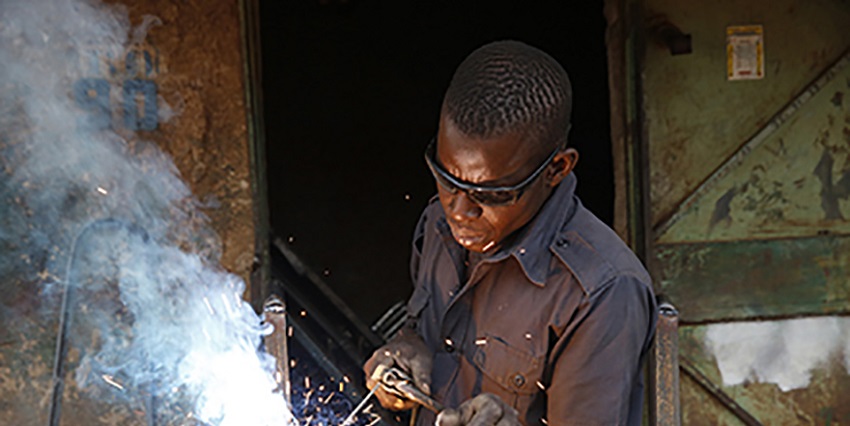Microfinance: a sector in full (r)evolution
By Amélie Riou and Alice Forgeois, Grameen Crédit Agricole Foundation

©Philippe Lissac / Godong
When we think of microfinance, we might think of small loans for populations without access to credit, only in the most remote and abandoned areas, by small operators managing their clients' outstanding loans on paper or old computers, solely to finance a business activity. In short, nothing revolutionary or innovative? Think again! Microfinance continues to evolve and adapt to its environment: better client relations and protections, digital services, and innovative product offerings to quickly meet essential needs. Let yourself be surprised!
Microfinance and GAFA*, a possible love story?
Microfinance is no longer the preserve of NGOs and specialized microfinance institutions. At least, not exclusively anymore. For the better? New players—internet, mobile, and digital giants—are taking an interest in microfinance and offering microloans. It's easy: they know their clients well and can exchange information and money with them very quickly. Some examples:
Baidu, the Chinese Google, is distributing microloans through its Chongqing subsidiary Baidu Micro Finance to ride the wave of consumer credit, which is growing strongly in China and, as of September 2017, represented a market worth 30.2 billion yuan (3.9 billion euros). Baidu said it uses big data, machine learning, and facial recognition technology to help it evaluate the credit files of potential borrowers. Microborrowers repay directly via a "wallet" application, and loan applications are made online. These loans are often intended to finance studies at private institutions (English language training, vocational training, or IT training).
At the same time, in September 2017, Amazon announced a partnership with Bank of Baroda (India) to offer microloans to individual sellers registered on the platform. To date, loans are offered to sellers who meet a number of criteria (Amazon account creation date, seller's sales history, customer returns, seller compliant with Amazon's e-commerce rules). Indian sellers will be able to directly use the profits from their sales to repay their loan. Amazon aims to attract 15 to 20% of Amazon India's customers in one year...! Be careful, digital technology can be a channel for the development of microfinance, but could ultimately be a factor of additional financial exclusion, recording and making available a large amount of information and borrower history...
Microfinance and macro-services?
Green microfinance, micronutrition, agricultural insurance... No apparent connection between these different themes? Well, yes. These services are now an integral part of the activities of microfinance institutions (MFIs) and complement traditional credit offerings. Gone are the days of the traditional model, and welcome to microfinance 2.0! Thanks to the geographic diversity of MFIs, the proximity they maintain with each client, and their strong rural roots, microfinance is becoming a preferred channel for the distribution of new services.
A team of researchers recently wanted to know if it was possible to use the MFI network to combat malnutrition, which is almost always linked to poverty in developing countries. The team therefore made micronutrients containing 15 essential vitamins and minerals available to the institutions and then measured the impact of this distribution through blood sampling. Following this study, this distribution network appeared to be very effective in combating malnutrition. To confirm the results, a study will be conducted throughout Haiti. Great developments are on the horizon!
Not very widespread in Africa but with immense potential for growth, agricultural microinsurance offers small producers the opportunity to insure their crops against various risks (climatic events, diseases, etc.). How can access to microinsurance be democratized? Through microfinance, in particular: the insurance product can be offered to the client along with a microcredit loan.
The range of credit products has also expanded considerably in recent years: specific microcredits for access to renewable energy, decent housing, etc. An increasingly broad range of products that allows us to best cover the needs of populations, on levels that are as different as they are necessary.
Microfinance: Towards New Horizons?
Historically intended for developing countries, microfinance is also present in Europe.
Why? It is presented as one of the possible responses to the economic crisis, social unrest, or financial exclusion, and is supported by governments. By whom? Thanks in particular to non-bank financial institutions and NGOs. For whom? According to the 8th Convergences Microfinance Barometer, the gross outstanding microcredit portfolio in Europe amounts to €2.5 billion, including €711 billion intended for professional purposes for people with limited access to financial resources. Under what conditions? The terms and conditions of these loans vary greatly between different European countries: from €31 billion in Poland, Finland, and France to €281 billion in Serbia, with average loans per borrower ranging from around €100 to a maximum of €25,000. In addition to microcredit, these European MFIs are increasingly offering additional services, such as savings, insurance, etc.
In addition to expanding to new countries, microfinance is adapting to countries where it has already been present for many years: Islamic microfinance is growing. Why? To satisfy potential beneficiaries who do not resort to traditional microfinance due to their religious beliefs. How? By adapting the traditional microfinance model to market products that comply with Sharia laws, mainly by removing the notion of interest rates from the products offered. What are the prospects? Still a minority compared to the sector as a whole, the Islamic microfinance market is growing rapidly in many countries. The three pioneering countries of this microfinance are Indonesia, Lebanon, and Bangladesh, but the model is expected to expand to improve financial inclusion for all. What are the impacts? The reach of this new type of microfinance is very significant in Muslim countries, given, for example, that approximately 561,000 Moroccans refuse to use microfinance for religious reasons.
_________________________________________________



Leave a Reply
Want to join the discussion?Feel free to contribute!